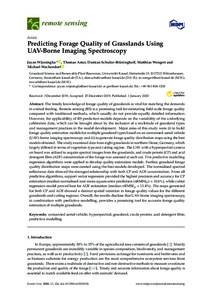| dc.date.accessioned | 2020-01-13T09:49:54Z | |
| dc.date.available | 2020-01-13T09:49:54Z | |
| dc.date.issued | 2020-01-01 | |
| dc.identifier | doi:10.17170/kobra-20200113913 | |
| dc.identifier.uri | http://hdl.handle.net/123456789/11413 | |
| dc.description.sponsorship | Gefördert durch den Publikationsfonds der Universität Kassel | ger |
| dc.language.iso | eng | eng |
| dc.rights | Urheberrechtlich geschützt | |
| dc.rights.uri | https://rightsstatements.org/page/InC/1.0/ | |
| dc.subject | unmanned aerial vehicle | eng |
| dc.subject | hyperspectral | eng |
| dc.subject | grassland | eng |
| dc.subject | crude protein | eng |
| dc.subject | acid detergent fibre | eng |
| dc.subject | predictive modelling | eng |
| dc.subject.ddc | 630 | |
| dc.title | Predicting Forage Quality of Grasslands Using UAV-Borne Imaging Spectroscopy | eng |
| dc.type | Aufsatz | |
| dcterms.abstract | The timely knowledge of forage quality of grasslands is vital for matching the demands in animal feeding. Remote sensing (RS) is a promising tool for estimating field-scale forage quality compared with traditional methods, which usually do not provide equally detailed information. However, the applicability of RS prediction models depends on the variability of the underlying calibration data, which can be brought about by the inclusion of a multitude of grassland types and management practices in the model development. Major aims of this study were (i) to build forage quality estimation models for multiple grassland types based on an unmanned aerial vehicle (UAV)-borne imaging spectroscopy and (ii) to generate forage quality distribution maps using the best models obtained. The study examined data from eight grasslands in northern Hesse, Germany, which largely differed in terms of vegetation type and cutting regime. The UAV with a hyperspectral camera on board was utilised to acquire spectral images from the grasslands, and crude protein (CP) and acid detergent fibre (ADF) concentration of the forage was assessed at each cut. Five predictive modelling regression algorithms were applied to develop quality estimation models. Further, grassland forage quality distribution maps were created using the best models developed. The normalised spectral reflectance data showed the strongest relationship with both CP and ADF concentration. From all predictive algorithms, support vector regression provided the highest precision and accuracy for CP estimation (median normalised root mean square error prediction (nRMSEp) = 10.6%), while cubist regression model proved best for ADF estimation (median nRMSEp = 13.4%). The maps generated for both CP and ADF showed a distinct spatial variation in forage quality values for the different grasslands and cutting regimes. Overall, the results disclose that UAV-borne imaging spectroscopy, in combination with predictive modelling, provides a promising tool for accurate forage quality estimation of multiple grasslands. | eng |
| dcterms.accessRights | open access | |
| dcterms.creator | Wijesingha, Jayan | |
| dcterms.creator | Astor, Thomas | |
| dcterms.creator | Schulze-Brüninghoff, Damian | |
| dcterms.creator | Wengert, Matthias | |
| dcterms.creator | Wachendorf, Michael | |
| dc.relation.doi | doi:10.3390/rs12010126 | |
| dc.type.version | publishedVersion | |
| dcterms.source.identifier | ISSN 2072-4292 | |
| dcterms.source.issue | Issue 1 | |
| dcterms.source.journal | Remote Sensing | eng |
| dcterms.source.pageinfo | 126 | |
| dcterms.source.volume | Volume 12 | |

